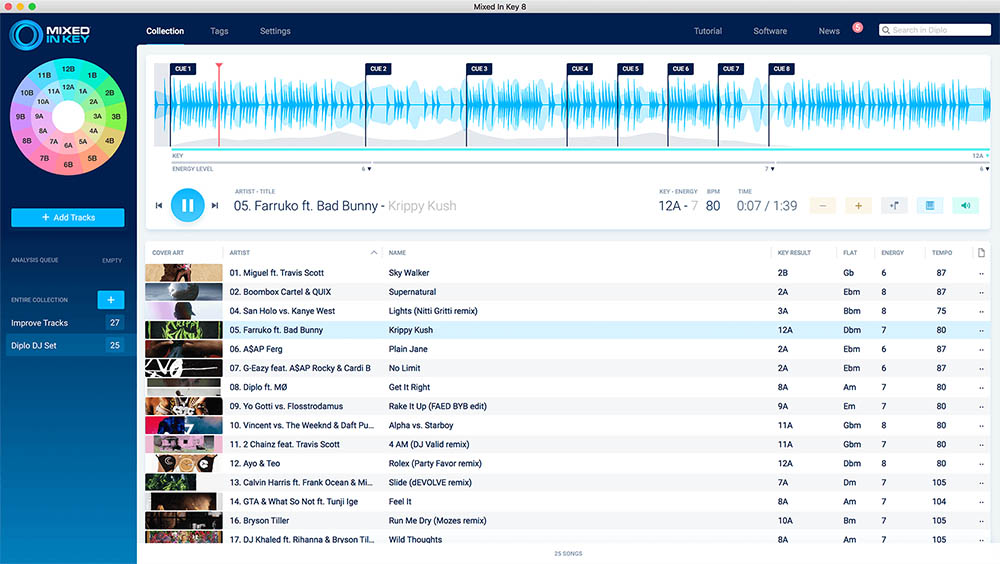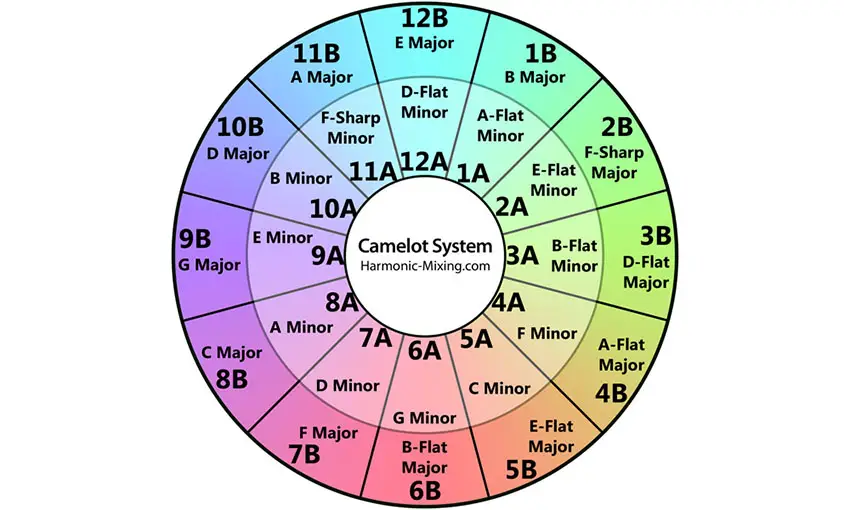Mixed in Key Chart – Everything You Need to Know
The idea for Mixed in Key was spawned all the way back in the 1970s disco craze by then-DJ Mark Davis. Decks were first being used in clubs and venues, mixers allowed for the connection and combination of multiple inputs and the DJ set was born!
Mark quickly realized that mixing has two different components: beatmatching and key/melody matching.
It’s obvious that tunes have to be sync’d to tempo if they’re playing alongside each other – this is the cornerstone of mixing. This was pretty difficult to achieve perfectly back in the day with no tempo indicator or accurate way of pitch fading to slow down or speed up records. Today, beatmatching has enhanced with new tech and BPM meters which show exact BPM to two decimal places.
Though matching the keys of tracks isn’t vital in every genre, in many genres like EDM, house, trance, disco, techno, etc, it’s pretty vital to mix melodically. Two tracks playing out of tune will sound pretty much as bad as two tracks playing out of time! If you repeat this throughout a set then your set will have no energy and will sound awkward.

All the best DJs mix their sets melodically to create shifts in energy, dramatic contrasts, downbeat and upbeat sections, etc. If you have an extremely well-trained ear then you could probably note down the relative keys of tracks yourself but even for those who are gifted with that ability, being able to transcribe it to a live DJ situation is nigh-impossible.
Yes, it is possible to mix in key more or less by accident but there are 24 different keys so the chances are low! Of course, you don’t have to match the exact key every single time – that would get quite dull – so there are other choices for mixing to other related keys. Some involve shifting dramatically upon in key, others involve shifting dramatically down and other techniques even use dissonance to create an atmospheric texture.
The Camelot Wheel assists not just with staying in the same key, but with transitioning in exciting ways between keys too.
To meet these creative needs, The Camelot Wheel was developed!

Does My Mixing Software Already Display Key?
Some mixing software does analyze for Camelot key but it’s not always accurate. Mixed in Key, the developers of the Camelot Wheel offer their own software. This software is highly accurate and comes with a host of extra features. It ‘plugs in’ to mixing software and writes your keys directly to tunes. That’s awesome because all you need to do is refer to the wheel or memorize some of the techniques required for melodic mixing.
The Benefits to Using Mixed in Key’s Camelot Wheel
- Mixing with keys takes your mixes to a new level
- Mixing in the right keys shows your musical understanding of the music and how it fits together
- It’s pretty easy to get to grips with the Camelot Wheel – it’s designed to be usable despite any preexisting musical knowledge (or lack of)
- Harmonic mixing creates a real musical mix which peaks and troughs dramatically
- Harmonic mixing works perfectly for heavily melodic music but even less melodic music like drum and bass benefits from key mixing
The Camelot Wheel
The Camelot Mixing Wheel was developed by Mark Davis to make key mixing more effective and easy to employ in DJ sets. Instead of trial and error in finding tunes which happen to have the same or related key, he saw that one could simply reference the tunes’ key against a chart to compare them.
The Camelot Wheel uses its own system to note the keys of different tracks. There’s a number, which indicates the key letter (e.g. F, F-sharp, D, etc) and a letter (A or B) which indicates either major or minor. E.g. 9A is E-minor.
Mixed in Key analyses tracks for their key and writes them according to the Camelot Wheel. Once you have a whole database of analysed tunes, you’re ready to rock and roll with the Camelot Wheel for effective and exciting melodic mixing.
The Basic Principle of the Camelot Wheel
Each segment of the Camelot Wheel has a long border with 3 other segments. These represent near, neighbouring and related keys. Mixing between these will create a harmonically seamless mix which makes the tracks sound melodically compatible.
It’s a safe bet to maintain your mix by mixing between these 3 options.
For example, 12A, D-flat minor, is next to 11A, F-sharp minor, 1A, A-flat minor and 12B, E major.
You can mix between these neighbouring keys to go up or down the Camelot Wheel.
A major to minor switch will alter the tone of the mix to become either a bit darker or more moody or melancholic (minor) or more upbeat and driven (major).
Switching to keys above or below will produce varying results depending on the keys. In our above example, A -flat minor is often used for rather romantic sounding music (in classical). Whether this is mirrored in techno, trance, EDM, etc? You’ll just have to see!
It’s worth noting that many tracks will be produced in the same or similar keys. A minor and F major are reportedly the two most popular keys for most electronic music – you’re likely to see those pop up more than other lesser used keys in electronic music particularly.
Experimentation is key. Load up your tracks and start comparing their keys. Mix between them and note what works – you’ll notice that mixing in key makes your mix sound better in almost every way! In fact, for many DJs, it’s a revelation. It saves so much time in manually trawling your collection for tracks that sound like they work together by ear. Also, for freestyle or improvised mixing, using the Camelot system prevents those dodgy moments where you drop a new tune which sounds completely different to the last and ultimately awkward and weird!
Summary
The Camelot Wheel is a cool system that makes harmonic mixing easily achievable. Simply analyze your tunes and you’re good to go! Mixed in Key is the industry leader but your usual mixing software can analyze and write key data. In the settings, make sure to select Mixed in Key Camelot style rather than traditional notation.
Mix in key for tighter, more powerful and more creative mixes today. Meanwhile, you can dig deeper into the topic and advance your DJ skills with some neat Camelot Wheels tricks that we have covered recently here.
You may also like: